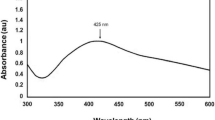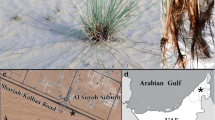Abstract
Synthesis of biogenic metal nanoparticles using plant extract has gained considerable attention in recent years. The present study aims to synthesize and investigate the cytotoxic effect of silver nanoparticles (AgNPs) from Dysosma pleiantha rhizome extract. The green biosynthesis of AgNPs was verified by ultraviolet visible spectrometer, and characterized using fourier transform infrared spectroscopy, transmission electron microscopy and scanning electron microscopy. Results of microscopic studies revealed that the synthesized AgNPs were a spherical shape with an average size of 76 nm. We also examined the anti-cancer activity of biologically synthesized AgNPs. The dose-dependent cytotoxicity was observed in the breast cancer cell lines MDA-MB-231 and MDA-MB-453 treated with biogenically synthesized AgNPs, and the IC50 was recorded at 33.521 and 36.25 µM respectively. The DNA fragmentation analysis showed that the MDA-MB-231 cells treated with increasing concentrations of AgNPs significantly triggered the fragmentation of DNA. In addition, the synthesized AgNPs exhibited dose dependent cytotoxic potential against human gastric cancer cell lines and the IC50 was recorded at 7.14 µM. Thus, the green biosynthesized AgNPs from D. pleiantha rhizome can be used in the novel development of anticancer drugs.





Similar content being viewed by others
References
Agnihotri S, Mukherji S, Mukherji S (2014) Size-controlled silver nanoparticles synthesized over the range 5–100 nm using the same protocol and their antibacterial efficacy. RSC Adv 4:3974–3983
Ahmed S, Ahmad M, Swami BL, Ikram S (2016) A review on plants extract mediated synthesis of silver nanoparticles for antimicrobial applications: a green expertise. J Adv Res 7:17–28
Al-Dhafri K, Ching CL (2019) Phyto-synthesis of silver nanoparticles and its bioactivity response towards nosocomial bacterial pathogens. Biocatal Agric Biotechnol 18:101075
Allen RT, Hunter WJ III, Agrawal DK (1997) Morphological and biochemical characterization and analysis of apoptosis. J Pharmacol Toxicol Methods 37:215–228
Annu A, Ahmed S, Kaur G, Sharma P, Singh S, Ikram S (2018) Evaluation of the antioxidant, antibacterial and anticancer (lung cancer cell line A549) activity of Punica granatum mediated silver nanoparticles. Toxicol Res 7:923–930
AshaRani P, Low Kah Mun G, Hande MP, Valiyaveettil S (2008) Cytotoxicity and genotoxicity of silver nanoparticles in human cells. ACS Nano 3:279–290
Azizi M, Ghourchian H, Yazdian F, Bagherifam S, Bekhradnia S, Nyström B (2017) Anti-cancerous effect of albumin coated silver nanoparticles on MDA-MB 231 human breast cancer cell line. Sci Rep 7:5178
Bair M-J, Chuang S-L, Lei W-Y, Chen C-L, Tian H-W, Chiang T-H, Su William W-Y, Lin C-C, Lo Y-TC, Jou Y-Y, Wu C-Y, Chia S-L, Wu M-S, Chen H-H, Lee Y-C, Wang Y-W (2019) Planning mass eradication of Helicobacter pylori infection for indigenous Taiwanese peoples to reduce gastric cancer. Available at SSRN: https://ssrn.com/abstract=3379812
Banerjee PP, Bandyopadhyay A, Harsha SN, Policegoudra RS, Bhattacharya S, Karak N, Chattopadhyay A (2017) Mentha arvensis (Linn.)-mediated green silver nanoparticles trigger caspase 9-dependent cell death in MCF7 and MDA-MB-231 cells. Breast Cancer 9:265
Behzadi S et al (2017) Cellular uptake of nanoparticles: journey inside the cell. Chem Soc Rev 46:4218–4244
Borase HP, Salunke BK, Salunkhe RB, Patil CD, Hallsworth JE, Kim BS, Patil SV (2014) Plant extract: a promising biomatrix for ecofriendly, controlled synthesis of silver nanoparticles. Appl Biochem Biotechnol 173:1–29
Chahar MK, Sharma N, Dobhal MP, Joshi YC (2011) Flavonoids: a versatile source of anticancer drugs. Pharmacogn Rev 5(9):1
Chiu S-W, Peng J-F, Wang T-H, Pan L-F, Pan L-K (2019) Survival rate prediction of breast cancer patients of 0-IV stages with and without radiotherapy via a revised Taylor series expansion algorithm: a population-based study in Taiwan. Technol Health Care 7:1–13
Chokkalingam M et al (2019) Facile synthesis of Au and Ag nanoparticles using fruit extract of Lycium chinense and their anticancer activity. J Drug Deliv Sci Technol 49:308–315
Devi TB, Ahmaruzzaman M, Begum S (2016) A rapid, facile and green synthesis of Ag@ AgCl nanoparticles for the effective reduction of 2, 4-dinitrophenyl hydrazine. New J Chem 40:1497–1506
Duan H, Wang D, Li Y (2015) Green chemistry for nanoparticle synthesis. Chem Soc Rev 44:5778–5792
Durán N, Silveira CP, Durán M, Martinez DST (2015) Silver nanoparticle protein corona and toxicity: a mini-review. J Nanobiotechnol 13:55
Gonçalves H Jr, Guerra MR, Duarte Cintra JR, Fayer VA, Brum IV, Bustamante Teixeira MT (2018) Survival study of triple-negative and non–triple-negative breast cancer in a Brazilian cohort. Clin Med Insights 12:11
Gorshkov V, Bubis JA, Solovyeva EM, Gorshkov MV, Kjeldsen F (2019) Protein corona formed on silver nanoparticles in blood plasma is highly selective and resistant to physicochemical changes of the solution. Environ Sci 6:1089
Gurunathan S, Raman J, Malek SNA, John PA, Vikineswary S (2013) Green synthesis of silver nanoparticles using Ganoderma neo-japonicum Imazeki: a potential cytotoxic agent against breast cancer cells. Int J Nanomed 8:4399
Hong J, Tsai Y, Novick D, Hsiao FC-H, Cheng R, Cheng J-S (2017) The economic burden of advanced gastric cancer in Taiwan. BMC Health Serv Res 17:663
Karuppaiya P, Satheeshkumar E, Chao W-T, Kao L-Y, Chen EC-F, Tsay H-S (2013) Anti-metastatic activity of biologically synthesized gold nanoparticles on human fibrosarcoma cell line HT-1080. Colloids Surf B 110:163–170
Karuppaiya P, Tsay HS (2015) Therapeutic values, chemical constituents and toxicity of Taiwanese Dysosma pleiantha–A review. Toxicol Lett 236:90–97
Krishnaraj C, Muthukumaran P, Ramachandran R, Balakumaran M, Kalaichelvan P (2014) Acalypha indica Linn: biogenic synthesis of silver and gold nanoparticles and their cytotoxic effects against MDA-MB-231, human breast cancer cells. Biotechnol Rep 4:42–49
Küünal S, Rauwel P, Rauwel E (2018) Plant extract mediated synthesis of nanoparticles. Emerging applications of nanoparticles and architecture nanostructures. Elsevier, Amsterdam, pp 411–446
Larguinho M, Baptista PV (2012) Gold and silver nanoparticles for clinical diagnostics—from genomics to proteomics. J Proteom 75:2811–2823
Lee K-H, Xiao Z (2003) Lignans in treatment of cancer and other diseases. Phytochem Rev 2:341–362
Madhu C, Balaji K, Sharada A, Shankar J (2017) Anticancer effect of silver nanoparticles (AgNP’s) from Decalepis hamiltonii: an in vivo approach. Mater Today 4:11947–11958
Mousavi B, Tafvizi F, Zaker Bostanabad S (2018) Green synthesis of silver nanoparticles using Artemisia turcomanica leaf extract and the study of anti-cancer effect and apoptosis induction on gastric cancer cell line (AGS). Artif cells, Nanomed Biotechnol 46:499–510
Palaniyandi K, Wang S, Chen F (2016) Chinese medicinal herbs as source of rational anticancer therapy. Medicinal plants-recent advances in research and development. Springer, New York, pp 327–362
Pantidos N, Horsfall LE (2014) Biological synthesis of metallic nanoparticles by bacteria, fungi and plants. J Nanomed Nanotechnol 5:1
Patil MP, Singh RD, Koli PB, Patil KT, Jagdale BS, Tipare AR, Kim G-D (2018) Antibacterial potential of silver nanoparticles synthesized using Madhuca longifolia flower extract as a green resource. Microb Pathog 121:184–189
Prabhu D, Arulvasu C, Babu G, Manikandan R, Srinivasan P (2013) Biologically synthesized green silver nanoparticles from leaf extract of Vitex negundo L. induce growth-inhibitory effect on human colon cancer cell line HCT15. Process Biochem 48:317–324
Rafique M, Sadaf I, Rafique MS, Tahir MB (2017) A review on green synthesis of silver nanoparticles and their applications. Artif cells, Nanomed Biotechnol 45:1272–1291
Ramya M, Subapriya MS (2012) Green synthesis of silver nanoparticles. Int J Pharm Med Biol Sci 1:54–61
Saravanakumar K, Chelliah R, MubarakAli D, Oh D-H, Kathiresan K, Wang M-H (2019) Unveiling the potentials of biocompatible silver nanoparticles on human lung carcinoma A549 cells and Helicobacter pylori. Sci Rep 9:5787
Sarkar S, Kotteeswaran V (2018) Green synthesis of silver nanoparticles from aqueous leaf extract of Pomegranate (Punica granatum) and their anticancer activity on human cervical cancer cells. Adv Nat Sci 9:025014
Sharma P, Pant S, Rai S, Yadav RB, Dave V (2018) Green synthesis of silver nanoparticle capped with Allium cepa and their catalytic reduction of textile dyes: an ecofriendly approach. J Polym Environ 26:1795–1803
Singh J, Singh T, Rawat M (2017) Green synthesis of silver nanoparticles via various plant extracts for anti-cancer applications. Nanomedicine 7:1–4
Sitarz R, Skierucha M, Mielko J, Offerhaus GJA, Maciejewski R, Polkowski WP (2018) Gastric cancer: epidemiology, prevention, classification, and treatment. Cancer Manag Res 10:239
Srikar SK, Giri DD, Pal DB, Mishra PK, Upadhyay SN (2016) Green synthesis of silver nanoparticles: a review. Green Sustain Chem 6:34
Srinath B, Namratha K, Byrappa K (2018) Eco-friendly synthesis of gold nanoparticles by Bacillus subtilis and their environmental applications. Adv Sci Lett 24:5942–5946
Swanner J, Mims J, Carroll DL, Akman SA, Furdui CM, Torti SV, Singh RN (2015) Differential cytotoxic and radiosensitizing effects of silver nanoparticles on triple-negative breast cancer and non-triple-negative breast cells. Int J Nanomed 10:3937
Vanlalveni C, Rajkumari K, Biswas A, Adhikari PP, Lalfakzuala R, Rokhum L (2018) Green synthesis of silver nanoparticles using Nostoc linckia and its antimicrobial activity: a novel biological approach. BioNanoScience 8:624–631
Vivek R, Thangam R, Muthuchelian K, Gunasekaran P, Kaveri K, Kannan S (2012) Green biosynthesis of silver nanoparticles from Annona squamosa leaf extract and its in vitro cytotoxic effect on MCF-7 cells. Process Biochem 47:2405–2410
Yezhelyev MV, Gao X, Xing Y, Al-Hajj A, Nie S, O’Regan RM (2006) Emerging use of nanoparticles in diagnosis and treatment of breast cancer. Lancet Oncol 7:657–667
Zhang T-T, Yang F, Li X-L, Zhao W, Xu J-J, Chen H-Y (2017) A multifunctional silver nanocomposite for the apoptosis of cancer cells and intracellular imaging. Chem Commun 53:5614–5617
Acknowledgements
This research did not receive any specific grant from funding agencies in the public, commercial, or not-for-profit sectors. First author wish to thank Dr. K.J. Senthil Kumar for his kind help during the cell culture analysis.
Author information
Authors and Affiliations
Contributions
PK performed the laboratory experiments and collected the data. PK and SE performed UV–visible Spectrophotometer and FTIR analysis. PK and HST interpreted the data, drafted and revised the manuscript. PK and HST designed and supervised the study. All authors read and approved the final version of the manuscript.
Corresponding authors
Ethics declarations
Conflict of interest
All authors declare no conflict of interest regarding this study.
Additional information
Publisher's Note
Springer Nature remains neutral with regard to jurisdictional claims in published maps and institutional affiliations.
Rights and permissions
About this article
Cite this article
Karuppaiya, P., Satheeshkumar, E. & Tsay, H.S. Biogenic synthesis of silver nanoparticles using rhizome extract of Dysosma pleiantha and its antiproliferative effect against breast and human gastric cancer cells. Mol Biol Rep 46, 4725–4734 (2019). https://doi.org/10.1007/s11033-019-04917-1
Received:
Accepted:
Published:
Issue Date:
DOI: https://doi.org/10.1007/s11033-019-04917-1




